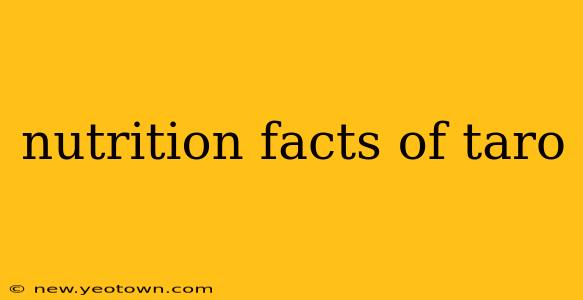Taro, that intriguing root vegetable with its subtly sweet and earthy flavor, has been a staple food in many cultures for millennia. But beyond its culinary appeal lies a wealth of nutritional benefits. This isn't just another starchy vegetable; taro packs a punch when it comes to vitamins, minerals, and other essential nutrients. Let's peel back the layers and uncover the surprising nutritional profile of this often-overlooked powerhouse.
What are the key nutrients found in taro?
Taro is a surprisingly good source of several essential nutrients. One cup of cooked taro provides a decent amount of carbohydrates, offering sustained energy throughout the day. But it's not just about carbs; taro is also a respectable source of dietary fiber, aiding in digestion and promoting gut health. Beyond this, you'll find a good dose of vitamin C, a powerful antioxidant crucial for immune function and collagen production. And it doesn't stop there; taro also contains vitamin B6, essential for brain development and function, as well as manganese, a mineral vital for bone health and metabolism.
Is taro a good source of protein?
While not a primary protein source like legumes or meat, taro does contribute a modest amount of protein to your diet. One cup of cooked taro provides around 2 grams of protein, which, while not substantial on its own, adds up when combined with other protein sources in a balanced meal. It's important to remember that the protein content can vary slightly depending on the variety of taro and how it's prepared.
How many calories are in a serving of taro?
A one-cup serving of cooked taro contains approximately 180-200 calories. This calorie count is relatively moderate compared to other starchy vegetables, making it a suitable addition to a weight-management diet. However, it's crucial to remember that the cooking method can influence the calorie count. For example, frying taro will significantly increase its calorie content.
What are the potential health benefits of eating taro?
The nutritional profile of taro translates into various potential health benefits. Its high fiber content promotes regular bowel movements and prevents constipation. The vitamin C content boosts the immune system, protecting against infections. Furthermore, the manganese in taro contributes to strong bones and healthy metabolism. Some research even suggests that taro may have anti-inflammatory properties, although more research is needed in this area.
Is taro suitable for people with dietary restrictions?
Taro is naturally gluten-free, making it a suitable choice for individuals with celiac disease or gluten sensitivity. However, it's essential to be aware of potential allergens. Some individuals may experience allergic reactions to taro, though this is relatively uncommon. Furthermore, those with diabetes should consume taro in moderation due to its carbohydrate content. Always consult with a healthcare professional or registered dietitian if you have any concerns about incorporating taro into your diet, particularly if you have pre-existing health conditions.
How can I incorporate taro into my diet?
Taro's versatility allows for various culinary applications. It can be boiled, steamed, roasted, or fried. It can be mashed like potatoes, added to soups and stews, or even used in desserts. Many cultures enjoy taro in various forms, from simple side dishes to complex main courses. Experiment with different cooking methods and recipes to find your favorite way to enjoy this nutritious root vegetable.
Conclusion: Taro – A Nutritious Addition to Your Plate
Taro's nutritional profile speaks for itself. It's a versatile, nutrient-rich vegetable deserving of a place in a balanced diet. From boosting immunity to aiding digestion, taro's benefits are numerous. So, the next time you're looking for a healthy and flavorful addition to your meals, remember the humble taro—a true unsung hero of the vegetable world.

